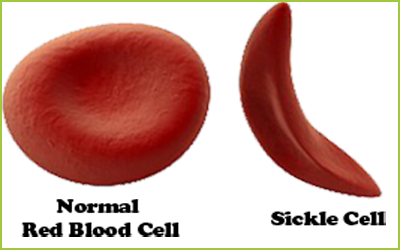|
|
Sickle Cell Anemia-Symptoms And Causes
Money Land Forum / Health / Sickle Cell Anemia-Symptoms And Causes (1 Post | 195 Views)
(1) (Go Down)
|
Sickle Cell Anemia-Symptoms And Causes by atoluwash(m) : 9:40 am On Nov 09, 2017 |
|
Sickle-cell disorder (SCD) is a set of blood ailments typically inherited from a individual's parents. cell disease (SCD) is a group of blood disorders typically inherited from a person's parents. The most common type is known as sickle-cell anaemia (SCA). It results in an abnormality in the oxygen-carrying protein haemoglobin (hemoglobin S) found in red blood cells. This contributes to a rigid, sickle-similar shape under certain conditions. Issues in sickle cell disease normally start around 5 to 6 weeks old. Lots of medical issues may develop, like strikes of pain ("sickle-cell emergency"), anemia, swelling at the feet and hands, bacterial diseases, and stroke. Long-term pain may grow as individuals get older. The average life expectancy at the developed globe is 40 to 60 decades.
 Sickle-cell disease occurs when a person inherits two abnormal copies of the haemoglobin gene, one from each parent. This gene happens in chromosome 11. Many subtypes exist, based on the precise mutation in every haemoglobin gene. An attack could be set off by temperature fluctuations, anxiety, dehydration, and higher altitude. Someone who has one abnormal copy does not normally have symptoms and can be thought to possess sickle-cell attribute. Such individuals can also be known as carriers. Diagnosis is with a blood evaluation and a few countries test all infants at birth for your illness. Identification is also a possibility while pregnant. Sickle cell anemia is an inherited form of anemia — a condition in which there aren't enough healthy red blood cells to carry adequate oxygen throughout your body. Normally, your red blood cells are flexible and round, moving easily through your blood vessels. In sickle cell anemia, the red blood cells become rigid and sticky and are shaped like sickles or crescent moons. These irregularly shaped cells can get stuck in small blood vessels, which can slow or block blood flow and oxygen to parts of the body. There's no cure for most people with sickle cell anemia. But treatments can relieve pain and help prevent problems associated with the disease. Symptoms of Sickle cell anemia Signs and symptoms of sickle cell anemia, which vary from person to person and change over time, include: Episodes of pain. Periodic episodes of pain, known as crises, are a significant symptom of sickle cell anemia. Infection develops when sickle-shaped red blood cells block blood circulation through tiny blood vessels into your torso, joints and abdomen. Pain may also occur on your bones. The pain varies in intensity and can last for a few hours to a few weeks. Some people have only a few pain episodes. Others have a dozen or more crises a year. If a crisis is severe enough, you might need to be hospitalized. Some adolescents and adults with sickle cell anemia also have chronic pain, which can result from bone and joint damage, ulcers and other causes. Frequent infections. Sickle cells can damage an organ which combats infection (spleen), which makes you more vulnerable to diseases. Doctors commonly give babies and children with sickle cell anemia antibiotics and vaccinations to stop possibly life-threatening illnesses, such as pneumonia. Painful swelling of hands and feet. The swelling is caused by sickle-shaped red blood cells blocking blood flow to the hands and feet. Causes of Sickle cell anemia Sickle cell anemia is caused by a mutation in the gene that tells the human body to generate the reddish, naturally-occurring chemical which gives blood its red colour (hemoglobin). Hemoglobin enables red blood cells to carry oxygen from the lungs to all areas of the body. In sickle cell anemia, the abnormal hemoglobin causes red blood cells to be stiff, tacky and misshapen. The sickle cell gene is passed from generation to generation within a pattern of inheritance called autosomal recessive inheritance. This implies that both the mother and the dad should pass on the defective form of the gene for a child to be affected. If just 1 parent passes the sickle cell gene into the child, this child is going to have the sickle cell trait. With one normal hemoglobin gene and a defective form of the gene, individuals with all the sickle cell trait make both standard hemoglobin and sickle cell regeneration. Their blood may comprise some sickle cells, however they normally do not have symptoms. However they're carriers of this diseases, so they may pass the gene to their children. Prevention of sickle cell anemia If you carry the sickle cell trait, seeing a genetic counselor before trying to conceive can help you understand your risk of having a child with sickle cell anemia. He or she can also explain possible treatments, preventive measures and reproductive options. Source: https://aderonkebamidele.com/sickle-cell-anemia-sy/ |
(1) (Reply)
Don’t Use Ginger If You Have Any of These Conditions! / Beauty Treatments for Pregnant Women / Von Hippel Lindau Disease-Signs, Symptoms And Treatment /
(Go Up)
| Money Land Forum - Copyright © 2016 - 2024 | Aderonke Bamidele (Admin). All rights reserved. Follow Money Land Forum on Facebook and Twitter Disclaimer: Every Money Land Forum member is solely responsible for anything that he/she posts or uploads on Money Land Forum. |

